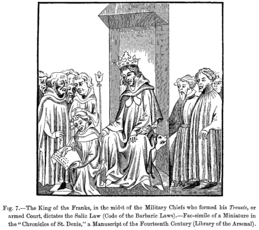507
Year 507 (DVII) was a common year starting on Monday (link will display the full calendar) of the Julian calendar. At the time, it was known as the Year of the Consulship of Anastasius and Venantius (or, less frequently, year 1260 Ab urbe condita). The denomination 507 for this year has been used since the early medieval period, when the Anno Domini calendar era became the prevalent method in Europe for naming years.
| Millennium: | 1st millennium |
|---|---|
| Centuries: | |
| Decades: | |
| Years: |
|
| 507 by topic |
|---|
| Leaders |
| Categories |
|
| Gregorian calendar | 507 DVII |
| Ab urbe condita | 1260 |
| Assyrian calendar | 5257 |
| Balinese saka calendar | 428–429 |
| Bengali calendar | −86 |
| Berber calendar | 1457 |
| Buddhist calendar | 1051 |
| Burmese calendar | −131 |
| Byzantine calendar | 6015–6016 |
| Chinese calendar | 丙戌年 (Fire Dog) 3203 or 3143 — to — 丁亥年 (Fire Pig) 3204 or 3144 |
| Coptic calendar | 223–224 |
| Discordian calendar | 1673 |
| Ethiopian calendar | 499–500 |
| Hebrew calendar | 4267–4268 |
| Hindu calendars | |
| - Vikram Samvat | 563–564 |
| - Shaka Samvat | 428–429 |
| - Kali Yuga | 3607–3608 |
| Holocene calendar | 10507 |
| Iranian calendar | 115 BP – 114 BP |
| Islamic calendar | 119 BH – 118 BH |
| Javanese calendar | 393–394 |
| Julian calendar | 507 DVII |
| Korean calendar | 2840 |
| Minguo calendar | 1405 before ROC 民前1405年 |
| Nanakshahi calendar | −961 |
| Seleucid era | 818/819 AG |
| Thai solar calendar | 1049–1050 |
| Tibetan calendar | 阳火狗年 (male Fire-Dog) 633 or 252 or −520 — to — 阴火猪年 (female Fire-Pig) 634 or 253 or −519 |

King Clovis I dictates the Salic Law
Events
By place
Eastern Roman Empire
- Emperor Anastasius I completes the strategic fortress at Dara (Northern Mesopotamia). He raises the city walls to 30 feet (10 m) disregarding Persian protests. Alarmed by the depredations of Slavs and Bulgars in Thrace, he builds the Anastasian Wall from the Black Sea to Propontis, across the narrow peninsula near Constantinople (modern Turkey).[1]
Europe
- Battle of Vouillé: A Frankish army under command of Clovis I invades the Visigothic Kingdom, and defeats king Alaric II near Poitiers. The Visigoths refuse to be enslaved and retreat to Septimania (Southern Gaul). Clovis annexes Aquitania and captures Toulouse.
- Gesalec succeeds his father Alaric II as king of the Visigoths. He establishes his residence at Narbonne and is supported by an alliance with the Ostrogothic king Theodoric the Great.
- Clovis I dictates the Salic Law (Code of the Barbaric Laws) to the Franks (a written codification of civil law for citizens of the Frankish Kingdom).
- Hermanafrid, king of the Thuringii, marries Amalaberga. He begins his rule, shared with his brothers Baderic and Bertachar.
- Wooden coffins and wooden tools are used in the burial places of the Alemanni.
Asia
- The town of Guilin, China, is renamed Guizhou.
- Keitai becomes the 26th emperor of Japan (approximate date).
- The first and smaller of the two Buddhas of Bamyan is erected in central Afghanistan.[2]
Births
- John of Ephesus, Armenian bishop (approximate date)
- Wen Di, emperor of Western Wei (d. 551)
- Xiao Zhuang Di, emperor of Northern Wei (d. 531)
- Yuwen Tai, general of Western Wei (d. 556)
Deaths
- Alaric II, king of the Visigoths
- Aprus, bishop of Toul
- Domangart Réti, king of Dál Riata (modern Scotland)
- Yu, empress of Northern Wei (b. 488)
gollark: If you put the U and S regional indicators together, they render as 🇺🇸. If you put random ones together, they probably won't.
gollark: The Unicode Consortium™ didn't want to try and define what is and isn't a country, so the flags are encoded as sequences of regional indicators.
gollark: And you know the flags? 🇺🇸 🇺🇦 etc.
gollark: 🇦 🇧 🇨 and whatever else.
gollark: So you know regional indicators?
References
- Essential Histories, Rome at War AD 293–696 (p. 52). Michael Whitby, 2002. ISBN 1-84176-359-4
- Cohen, Roger. "Return to Bamiyan", The New York Times, October 29, 2007. Accessed October 29, 2007.
This article is issued from Wikipedia. The text is licensed under Creative Commons - Attribution - Sharealike. Additional terms may apply for the media files.